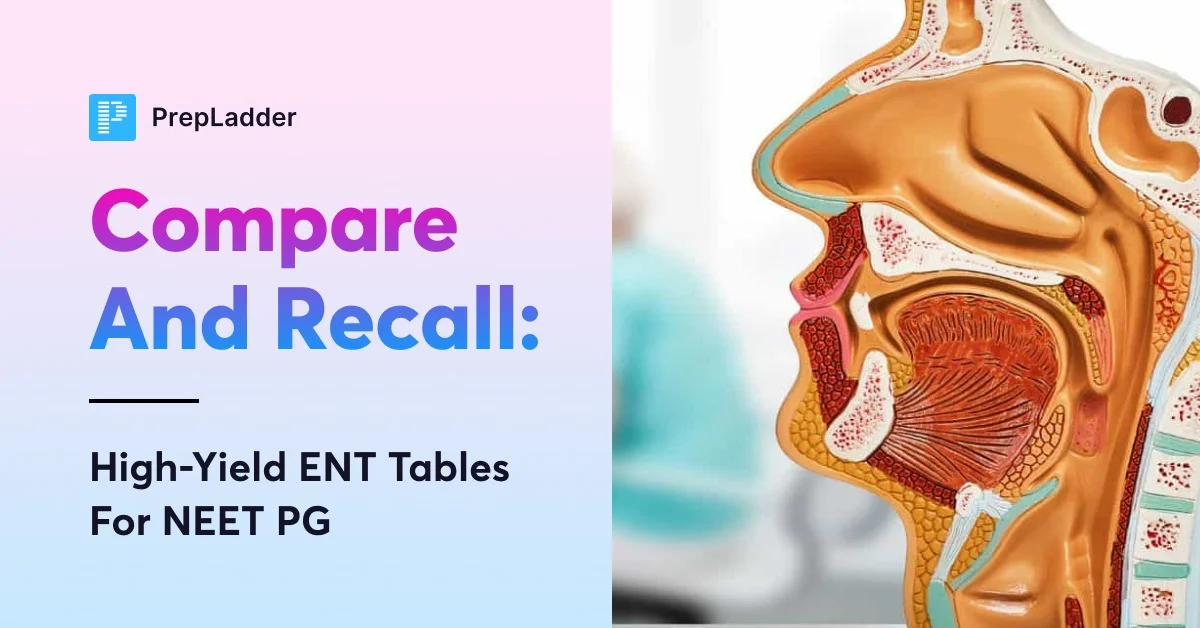Compare & Recall: High-Yield ENT Tables for NEET PG
Jul 29, 2025
Navigate Quickly
Table 1
Saccule and Utricle
Table 2
Ossicles Development
Table 3
Peripheral vestibular disorders and Central vestibular disorders
Table 4
Summary of the Stages of ASOM
Table 5
Difference Between ASOM and SOM
Table 6
Comparison between canal wall up and canal wall down procedures
Table 7
Rhinitis Medicamentosa versus Drug-Induced Rhinitis
Table 8
Comparison between Rhinoscleroma and Rhinosporidiosis
Table 9
Comparison of Antrochoanal Polyp and Ethmoidal Polyp
Table 10
Cavernous Sinus Thrombosis V/S Orbital Cellulitis

Table 1
Saccule and Utricle
|
Utricle |
Saccule |
|
|
Table 2
Ossicles Development
Ear part Embryonic layer Arch Pinna Mesoderm 1 and 2 arch External auditory canal Ectoderm 1st cleft Tympanic membrane All three layers 1st cleft and 2nd pouch along with mesoderm Middle ear cleft Endoderm 1st and 2nd forms tubo tympanic recess Malleus and incus Mesoderm 1st arch Stapes Mesoderm 2nd arch Superstructure of stapes Mesoderm 2nd arch Foot plate of stapes Mesoderm Otic capsule Mastoid Mesoderm Squamous and petrous parts of temporal bone 
Table 3
Peripheral vestibular disorders and Central vestibular disorders
Peripheral vestibular disorders Central vestibular disorders Meniere's Disease Vertebrobasilar insufficiency Benign Paroxysmal Positional Vertigo (BPPV) PICA syndrome Vestibular neuronitis Basilar migraine Labyrinthitis Cerebellar disease Vestibulotoxic drugs Multiple sclerosis Perilymph fistula Tumors of brainstem Acoustic neuroma Epilepsy Meniere's BPPV Vestibular neuritis Labyrinthitis PF Vertigo Minutes to Hours Sec to min Days - weeks Days - Weeks Intermittent Vertigo Hallmark symptom Vagal Positional Post viral Post viral Sx, Trauma, CSOM Hearing loss Present (Low frequency SNHL) Absent Absent SNHL +/- Tinnitus Roaring Absent Absent Present +/-
Table 4
Summary of the Stages of ASOM
Stage Pathology Symptoms Signs 1. Tubal occlusion Oedema of ET leading to negative pressure and retraction of TM Mild deafness and ear ache Retracted TM 2. Pre-suppuration Invasion of organism and mild inflammatory exudate Fever and severe deafness Cart wheel TM (congested TM) 3. Suppuration Frank Pus in the middle ear. High grade fever, excruciating ear ache, deafness Bulging tympanic membrane 4. Resolution TM ruptures with release of pus Everything decreases Small perforation in anterio- inferior pars tensa with hyperemia of TM
Table 5
Difference Between ASOM and SOM
ASOM SOM Cause Usually infective: Streptococcus pneumonia Non-infective cause. (nasal or nasopharyngeal cause) Symptoms Pain, hearing loss, and fever. Hearing loss, poor school performance, inattention. Signs Mild retraction progressing to Cartwheel appearance, bulging tympanic membrane, perforation, pulsatile otorrhea, and lighthouse sign Presence of air bubbles and air-fluid level (hallmark for SOM). Investigation None. Tuning fork test, audiometry, and tympanometry (B type of audiogram) (diagnostic test). Treatment Medical therapy: antibiotics, nasal decongestants, analgesics, and anti- inflammatory drugs. Surgery includes myringotomy at the posteroinferior quadrant and curvilinear incision Initially wait and watch and provide medical therapy for 3 months. Beyond three months, myringotomy with grommet and treatment of the underlying cause. The site of myringotomy is the anteroinferior quadrant with radial incision.
Table 6
Comparison between canal wall up and canal wall down procedures
Canal wall up Canal wall down Meatus Normal appearance Widely open meatus communicating with mastoid Cleaning requirement No cleaning required Cleaning mastoid cavity once or twice a year Recurrence or residual disease High rate Low rateThus, a safe procedure Second Look Surgery Second look after six months to rule out cholesteatoma Not required Limitations No limitations, swimming is allowed. Swimming can lead to mastoid cavity infection, so is curtailed. Auditory Rehabilitation Easy to wear a hearing aid if necessary Problems in fitting hearing aid due to large meatus and mastoid cavity and risk of infection
Table 7
Rhinitis Medicamentosa versus Drug-Induced Rhinitis
|
Rhinitis Medicamentosa |
Drug induced Rhinitis |
→ on chronic use → reduced response → down regulation of receptors (due to tolerance) → increases parasympathetic and decreases sympathetic activity → nasal congestion and nasal discharge
|
|
Table 8
Comparison between Rhinoscleroma and Rhinosporidiosis
Rhinoscleroma Rhinosporidiosis Cause Bacterial infection (Gram-negative) Aquatic protozoa Mode of Infection Air droplets Water borne Stages of Pathogenesis 3 stages Multiples in epidermis and results in vascular mass. Clinical appearance Hebra nose, tapir nose, and woody hard nodule Strawberry like mass Diagnosis HPE and culture gives diagnosis. Mikulicz cells and Russell bodies are present HPE Presence of sporangia with spores Treatment Medical therapy with adjuvant surgery Mainly surgery with medical treatment to prevent a recurrence.
Table 9
Comparison of Antrochoanal Polyp and Ethmoidal Polyp
Antrochonal Polyp Ethmoidal Polyp Age Young Middle-aged and adult Etiology Infection Allergy Number Single Multiple Laterality Unilateral Bilateral Origin Maxilary sinus Ethmoid sinus Growth Posteriorly Anteriorly Medical Treatment No role In initial phase Surgery FESS FESS Recurrence Less High
Table 10
Cavernous Sinus Thrombosis V/S Orbital Cellulitis
Cavernous sinus thrombosis Orbital cellulitis Source Nose, sinuses, orbit, ear or pharynx Ethmoid sinuses Onset Abrupt with chills and rigors Slow Toxemia Present Late Laterality Bilateral Unilateral Edema of eyelids Bilateral edema of eyelids, chemosis and proptosis Unilateral edema of eyelids, near the inner canthus ® chemosis and proptosis Cranial nerve involvement Individual and sequential Concurrent with complete ophthalmoplegia
Download the PrepLadder app now and unlock a 24-hour FREE trial of premium high-yield content. Access Smarter Video Lectures also in हिंglish, Game Changing Qbank, Audio QBank, Structured Notes, Treasures, Mock test for FREE to ace your NEET PG preparation. Elevate your study experience and gear up for success. Start your journey with PrepLadder today!

PrepLadder Medical
Get access to all the essential resources required to ace your medical exam Preparation. Stay updated with the latest news and developments in the medical exam, improve your Medical Exam preparation, and turn your dreams into a reality!
PrepLadder Version X for NEET PG
Avail 24-Hr Free Trial
